Ready, Set, Go
Get Ready
Being Ready for wildfire starts with maintaining an adequate defensible space and by hardening your home. Defensible space is the buffer you create by removing dead plants, grass and weeds. Hardening your home means using construction materials that can help your home withstand flying embers finding weak spots in the construction, which can result in your house catching fire.
Defensible Space Zones
THREE ZONES described below make up the required 100 feet of defensible space.
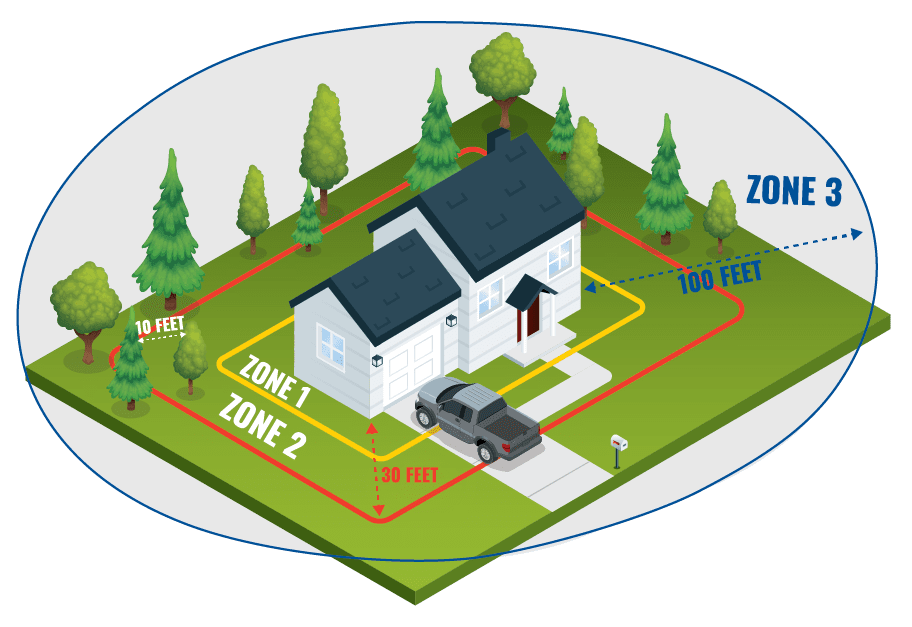
Immediate ZONE 1: extends 0-5 feet out from your house, garage and other structures
- Clean roofs and gutters of dead leaves, debris and pine needles that could catch embers.
- Replace or repair any loose or missing shingles or roof tiles to prevent ember penetration.
- Reduce embers that could pass through vents in the eaves by installing 1/8 inch metal mesh screening.
- Clean debris from exterior attic vents and install 1/8 inch metal mesh screening to block embers.
- Repair or replace damaged or loose window screens and any broken windows.
- Screen or box-in areas below patios and decks with wire mesh to prevent debris and combustible materials from accumulating.
- Move any flammable material away from wall exteriors – mulch, flammable plants, leaves and needles, firewood piles – anything that can burn. Remove anything stored underneath decks or porches.
Intermediate ZONE 2: extends 30 feet out
- Remove all dead plants, grass and weeds (vegetation).
- Remove dead or dry leaves and pine needles from your yard, roof and rain gutters.
- Trim trees regularly to keep branches a minimum of 10 feet from other trees.
- Remove branches that hang over your roof and keep dead branches 10 feet away from your chimney.
- Create a separation between trees, shrubs and items that could catch fire, such as patio furniture, wood piles, swing sets, etc.
Extended ZONE 3: extends 100 feet out
- Cut or mow annual grass down to a maximum height of 4 inches.
- Create horizontal spacing between shrubs and trees. (See diagram)
- Create vertical spacing between grass, shrubs and trees. (See diagram)
- Dispose of heavy accumulations of ground litter/debris.
- Remove dead plant and tree material.
- Remove small conifers growing between mature trees.
- Remove vegetation adjacent to storage sheds or other outbuildings within this area.
- Trees 30 to 60 feet from the home should have at least 12 feet between canopy tops.
- Trees 60 to 100 feet from the home should have at least 6 feet between the canopy tops.
Plant and Tree Spacing
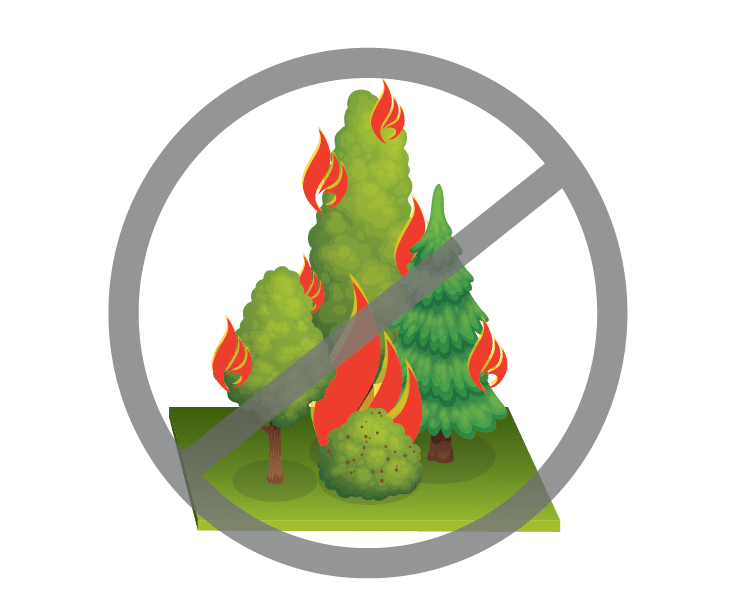 The spacing between grass, shrubs, and trees is crucial to reducing the spread of wildfires.
The spacing between grass, shrubs, and trees is crucial to reducing the spread of wildfires.
See below for information on Vertical and Horizontal spacing.
Vertical Spacing
Remove all tree branches at least 6 feet from the ground.
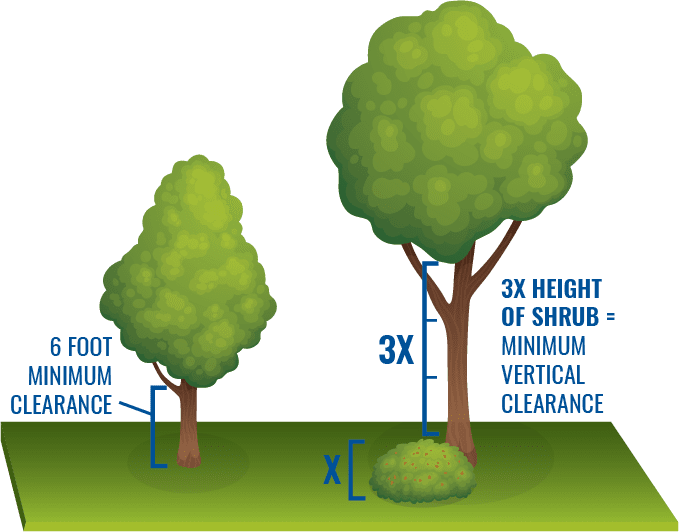
Example: A five foot shrub is growing near a tree. 3×5 = 15 feet of clearance needed between the top of the shrub and the lowest tree branch.
Horizontal Spacing
Horizontal spacing depends on the slope of the land and the height of the shrubs or trees. Check the chart below to determine spacing distance.
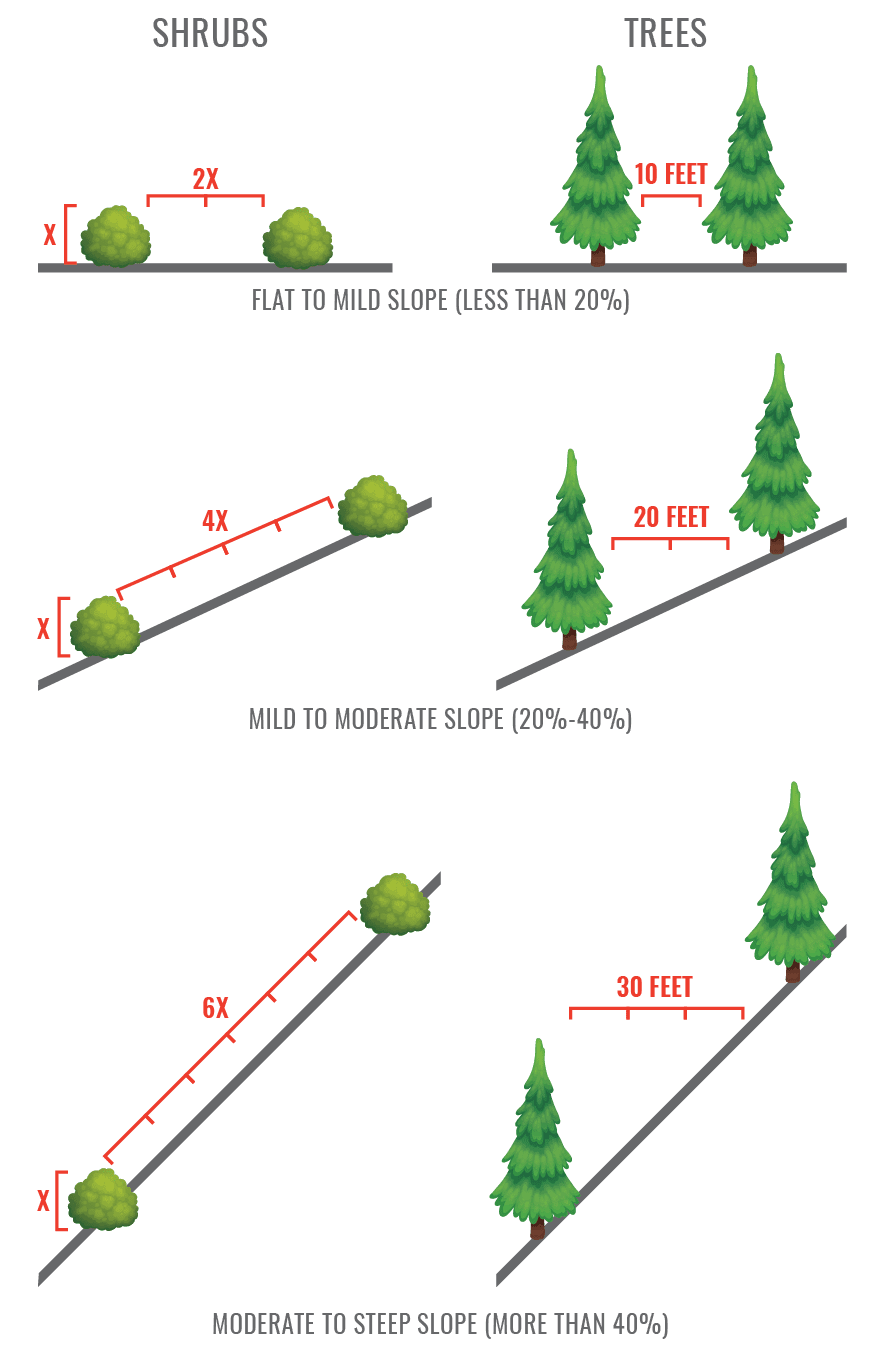
Fire-Safe Landscaping
Fire-safe landscaping isn’t necessarily the same thing as a well-maintained yard. Fire-safe landscaping uses fire-resistant plants that are strategically planted to resist the spread of fire to your home.
Create a Fire-Smart Yard: https://firesafemarin.org/create-a-fire-smart-yard/
Harden Your Home
Flying embers can ignite homes up to a mile from a wildfire. “Harden” your home now before a wildfire starts by using fire-resistant building materials.
Review the following items to learn how to harden your home and make it more fire resistant.
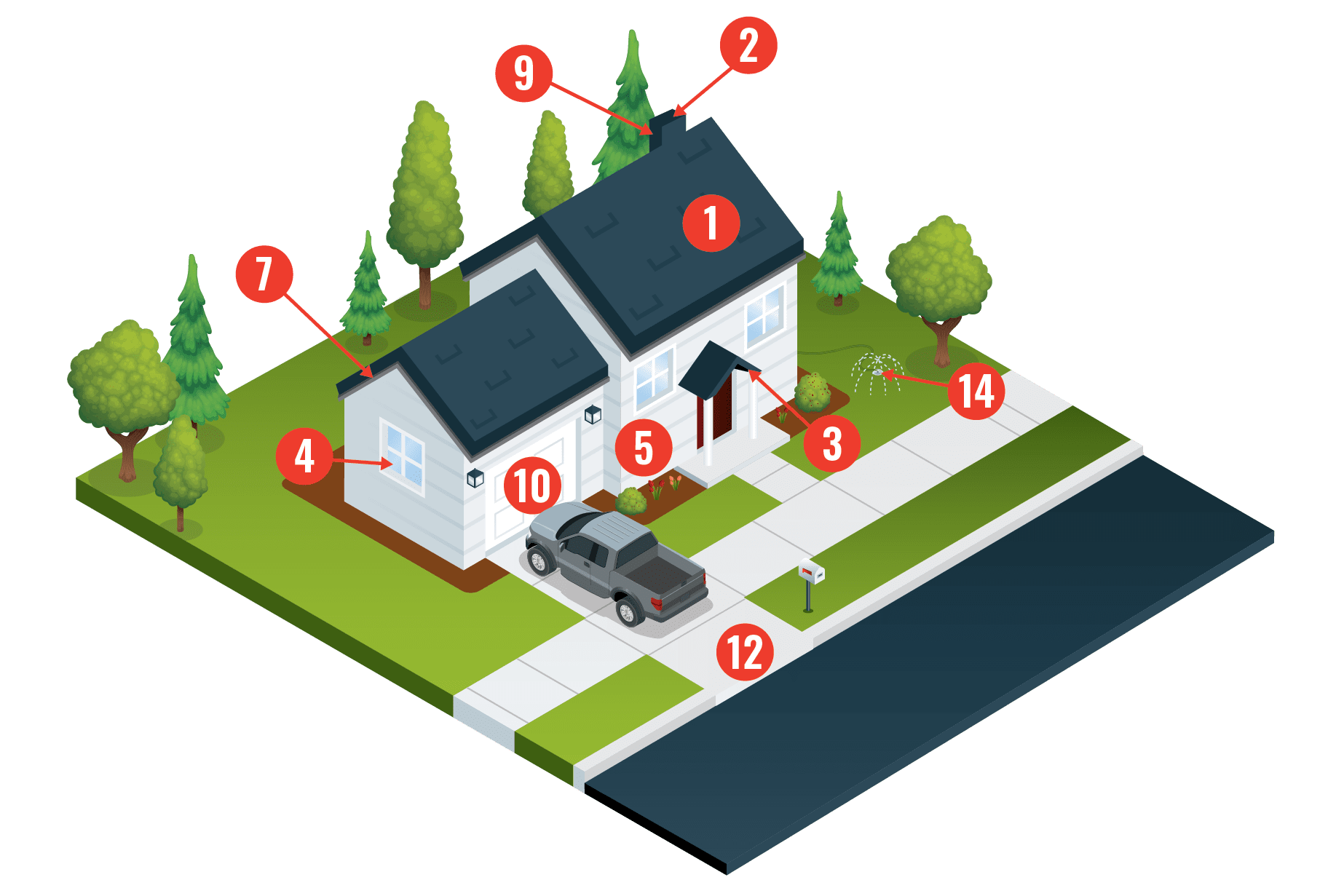
1) Roof
Build your roof or re-roof with materials such as composition, metal or tile. Block any spaces between roof decking and covering to prevent embers from catching.
2) Vents
Vents on homes create openings for flying embers.
- Cover all vent openings with 1/8-inch to 1/4-inch metal mesh. Do not use fiberglass or plastic mesh because they can melt and burn.
- Protect vents in eaves or cornices with baffles to block embers (mesh is not enough).
3) Eaves and Soffits
Eaves and soffits should be protected with ignition-resistant or non-combustible materials.
4) Windows
Heat from a wildfire can cause windows to break even before the home ignites. This allows burning embers to enter and start fires inside. Single-paned and large windows are particularly vulnerable.
- Install dual-paned windows with one pane of tempered glass to reduce the chance of breakage in a fire.
- Consider limiting the size and number of windows that face large areas of vegetation.
5) Walls
Wood products, such as boards, panels or shingles, are common siding materials. However, they are combustible and not good choices for fire-prone areas.
- Build or remodel your walls with ignition resistant building materials, such as stucco, fiber cement, wall siding, fire retardant, treated wood, or other approved materials.
- Be sure to extend materials from the foundation to the roof.
6) Decks
Surfaces within 10 feet of the building should be built with ignition-resistant, non-combustible, or other approved materials.
- Ensure that all combustible items are removed from underneath your deck.
7) Rain Gutters
Screen or enclose rain gutters to prevent accumulation of plant debris.
8) Patio Cover
Use the same ignition-resistant materials for patio coverings as a roof.
9) Chimney
Cover your chimney and stove pipe outlets with a non-combustible screen. Use metal screen material with openings no smaller than 3/8-inch and no larger than 1/2-inch to prevent embers from escaping and igniting a fire.
10) Garage
Have a fire extinguisher and tools such as a shovel, rake, bucket, and hoe available for fire emergencies.
- Install weather stripping around and under the garage door to prevent embers from blowing in.
- Store all combustible and flammable liquids away from ignition sources.
11) Fences
Consider using ignition-resistant or non-combustible fence materials to protect your home during a wildfire.
12) Driveways and Access Roads
Driveways should be built and maintained in accordance with state and local codes to allow fire and emergency vehicles to reach your home. Consider maintaining access roads with a minimum of 10 feet of clearance on either side, allowing for two-way traffic.
- Ensure that all gates open inward and are wide enough to accommodate emergency equipment.
- Trim trees and shrubs overhanging the road to allow emergency vehicles to pass.
13) Address
Make sure your address is clearly visible from the road.
14) Water Supply
Consider having multiple garden hoses that are long enough to reach all areas of your home and other structures on your property. If you have a pool or well, consider getting a pump.
For more home hardening resources & information, visit Insurance Institute for Business & Home Safety (IBHS): https://disastersafety.org/wildfire/
Red Flag Warning
What is a RED FLAG WARNING?

A RED FLAG WARNING is a notice issued by the National Weather Service (NWS) that weather conditions in the next 24 hours may result in extreme fire behavior. These conditions may include:
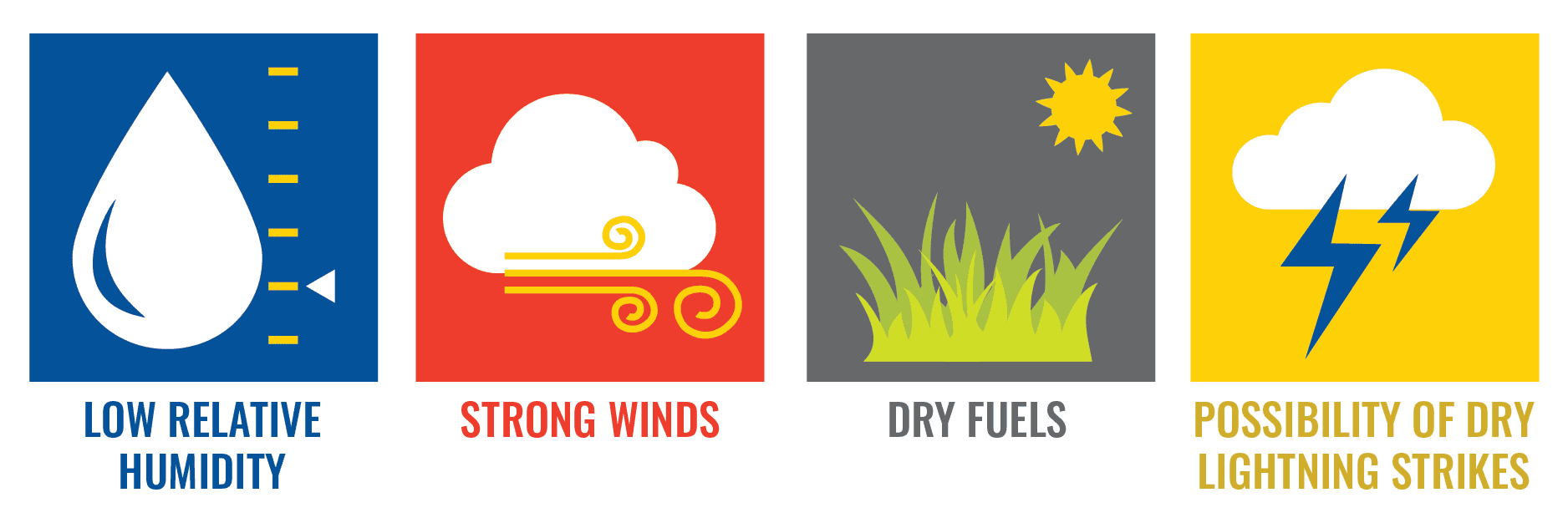
Red Flag Warnings are often preceded by a Fire Weather Watch, which is also a NWS notice indicating that weather conditions in the next 12-72 hours may result in extreme fire behavior and trigger a Red Flag Warning.
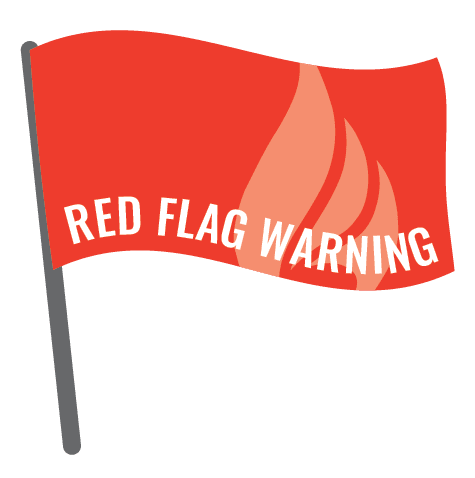 During a Red Flag Warning, Santa Clara County Fire Department and partner fire and County agencies may:
During a Red Flag Warning, Santa Clara County Fire Department and partner fire and County agencies may:
- Place red flags outside of fire stations.
- Send informational alerts, post information on social media and notify local media outlets.
- Increase staffing and staff additional fire equipment.
- Patrol highly vulnerable areas.
- Suspend open burning.
- Review cooperative plans with law enforcement, local government officials and neighboring fire departments.
BE AWARE during Red Flag Warnings!
 Be sure you are signed up for Santa Clara County emergency alerts through AlertSCC and able to receive alerts when at home, work and school.
Be sure you are signed up for Santa Clara County emergency alerts through AlertSCC and able to receive alerts when at home, work and school.
Review your family evacuation plan and be ready to gather family members, pets and valuables in case an evacuation is required. Consider moving pets or livestock to safer areas until Red Flag Warning has ended.
Report any sign of smoke or fire immediately by dialing 9-1-1.
Red Flag Warning Reminders:
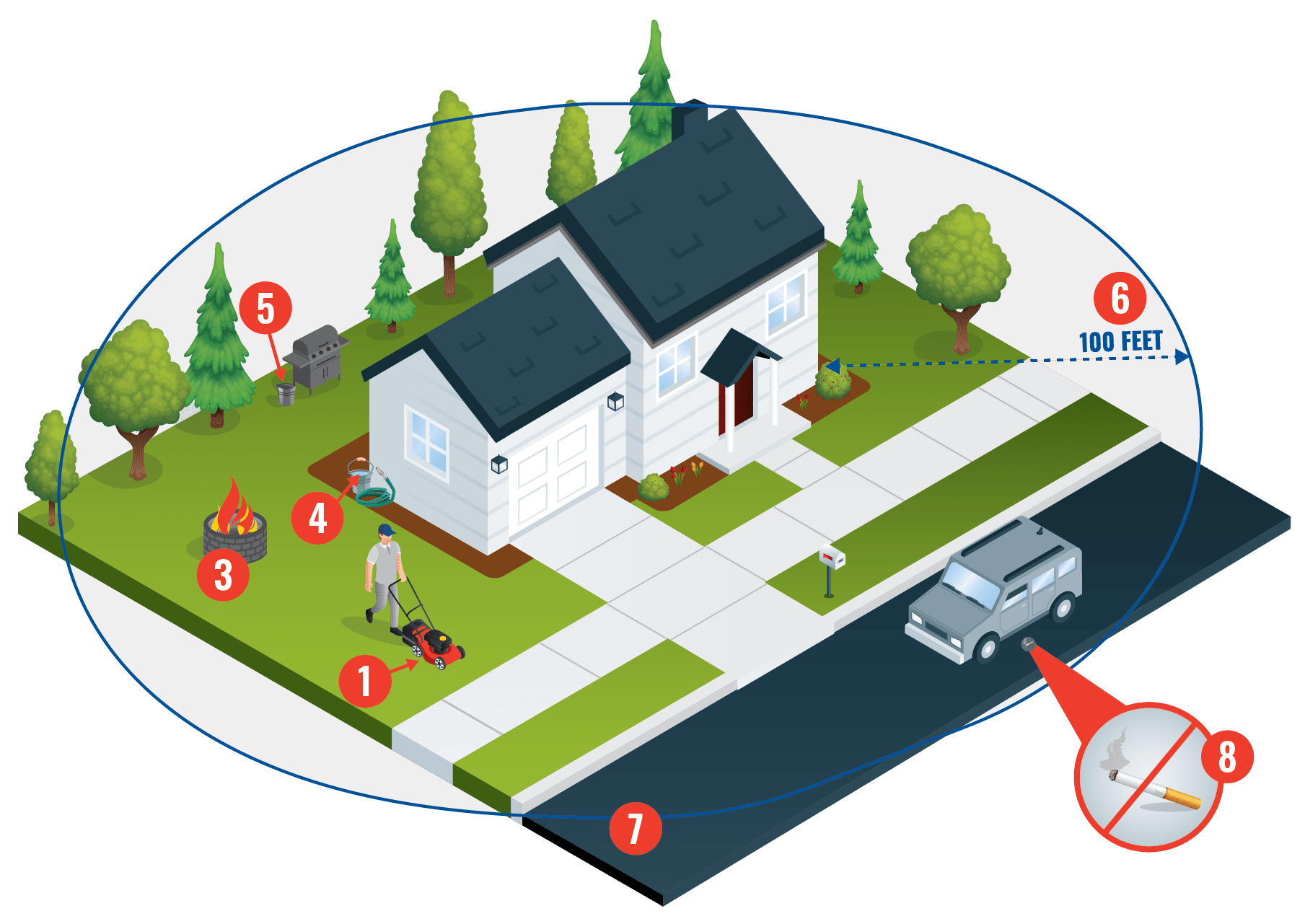
EQUIPMENT
-
- Do not use lawnmowers or spark-producing equipment in or near dry vegetation. Follow local fire restrictions on powered equipment use.
OUTDOOR FIRES
-
- Report unattended outdoor fires immediately to 911.
- Avoid all outdoor burning.
- Extinguish outdoor fires properly, never leave barbecues or cooking fires unattended. Always drown them with plenty of water.
- Soak ashes and charcoal in water and dispose of them in a metal can. These materials can ignite days after a fire or BBQ is extinguished.
PROPERTY
-
- Be READY for wildfire by maintaining at least 100 feet of defensible space around your home.
- Ensure access roads to your home are cleared and properly labeled.
VEHICLES
- Do not throw cigarettes or matches out of a vehicle. They can ignite dry vegetation on the side of the road and start a wildfire.
- Do not pull your vehicle over in dry grass.
- Ensure trailer chains do not drag on the ground.


